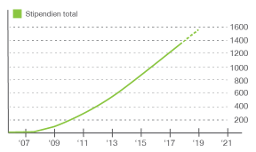Our clear focus on sustainable impact and newly launched goal to empower 1'000 Young Entrepreneurs have allowed us to take the lead.
Blog
Evidence on the Impact of Scholarship Programs on Education Outcomes in Developing Countries
Posted on 11/20/2017 at 12:43PM
14th November 2017
Adina Rom – ETH Zurich and Policy Analytics (www.policyanalytics.ch)
Dina Pomeranz – University of Zurich
Joao Garcia – George Washington University
Education is key for increasing for economic growth and rising living standards. While enrollment for primary education has increased rapidly and is now nearly universal across the globe many challenges remain: Teacher and student absenteeism is high in many developing countries, many children do not learn much despite attending school and enrollment drops sharply for secondary education (Glewwe and Muralidharan 2015).
Governments, NGOs and research are therefore concerned with the following questions (1) What interventions increase students’ enrollment, attendance and schooling completion? (2) How can we increase students learning and finally (3) given limited resources, what policies are most cost-effective to achieve these goals?
While there are a number of demand and supply side interventions to improve education outcomes we focus here on merit- and need-based scholarships. There are a number of reasons why parents may underinvest in children’s’ education, including (1) they might be credit constrained and unable to access the necessary means (2) they might underestimate the returns to education (3) they might undervalue the returns since they are far in the future (present bias) and finally (4) they might not account for spillovers from their children being educated (Glewwe and Muralidharan 2015). Scholarships can address such underinvestment by providing resources for children’s education in addition to what parents are willing or able to pay. In recent years a number of impact evaluations have been conducted on scholarships. Overall, the findings suggest that merit-based scholarships can effectively increase test scores and attendance while needs-based scholarships tend to affect enrollment and attendance, but not test scores. However, there can be an equity issue, as merit-based scholarships typically reach children who are already better off. One way to circumvent potential efficiency-equity trade-offs is by first targeting low income students and then award merit-based scholarships among them.
Merit-based scholarships increase test scores
In addition, to addressing the constraint mentioned above, merit-based scholarships might motivate children to make a bigger effort (as the returns to education are far in the future and the effort is now, which makes it hard to make that investment now). A number of rigorous studies suggest that at merit-based scholarships are particularly effective to increase test scores.
Kremer, Miguel and Thornton (2009) study a merit-based scholarship program for girls in Kenyan primary schools. Girls in the top 15 percent of a government-administered test were eligible to receive payment of school fees and an amount paid to the family for school supplies. They find large effects on eligible girls’ attendance rate, as well as test scores, on the order of 0.1 to 0.2 standard deviations for one of the study locations. Interestingly, in the schools offering the scholarship program, there were positive effects even for girls with lower grades (that are unlikely to win) and, to a lesser extent, for boys (that are ineligible). To help explain this finding, they also find an increase in teacher attendance, and anecdotal evidence that this is due to increased monitoring from parents interested in the scholarships. They find no evidence of lower motivation or worse study habits after the program ended.
In a second study Friedman et al. (2011) study the impact of the same program 4-5 years after the program started. They find that the girls who participated in the program were 8.6 percentage points more likely to enroll in secondary school and experienced a 0.2 standard deviation increase in test scores.
A study from Benin (Blimpo 2014) examines a program that randomly assigns cash prizes that was either awarded to individuals who achieved a certain learning goal, to a team of students if they achieved the goal as a team, or to a team that won a competition with other teams. In the first two interventions winners got a prize of $10 per person for a relative low level of performance and $40 per person for a high level. For the competition, the winners received a much larger prize of $640 for each participant. However, only one of 84 teams won this prize. All interventions led to a similar and statistically significant increase in test scores (0.24 to 0.28 standard deviations).
Li et al. (2014), evaluated a scholarship program in China. The looked at both individual prizes and peer-prizes. In the individual prizes treatment, groups of 10 low performing students would enter a competition, where the student with the largest learning improvement would get $13, the second and the third $6 and everyone else $3. As for the peer-prizes low preforming students were paired with high preforming students and both would get the same cash prize. The individual-prizes had no statistically significant impact. However, the peer-prizes led to an increase in test scores of 0.27 standard deviations. Suggesting that increasing school outcomes was only possible for the weaker students if they received pedagogical support (Glewwe and Muralidharan 2015).
Needs based scholarships increase attendance
One of the criticism of merit-based scholarships is that they often go to relatively more well-off households, exacerbating inequality (Orfield, 2002). Moreover, theories from psychology suggest the inclusion of extrinsic rewards could undermine students’ intrinsic motivation, resulting in worsening outcomes when the incentive is removed (see, for example, Lepper, Greene, and Nisbett. (1973); Benabou and Tirole (2003); and Deci, Koestner, and Ryan (2001)). However, we do not see evidence for such a worsening in the studies mentioned above (Kremer, Miguel and Thornton, 2009). Finally, the fear is that students could game the incentive: they might take less courses to maintain high performance, cram for the test or outright cheat (in the context of a developed country, see Binder, Ganderton, and Hutchens (2002)). For these reasons, a number of studies look at the effects of need-based scholarships.
Regarding purely need-based scholarship, Filmer and Schady (2008) and Filmer and Schady (2011) analyze two such programs in Cambodia. They find that even a modest valued benefit (around 2 to 3 percent of the median recipient household income) increases school enrollment and attendance by 25 to 30 percentage points. However, there are no impacts on math and vocabulary tests, indicating recipients are no better academically than they would otherwise be. This is explained by selection effects: students sensitive to the program are likely to be those who are less likely to benefit from Cambodian schools. They also find some limited impacts on some non-learning outcomes (knowledge of health practices and adolescent mental health), but not others (expectations for the future, desired age of marriage/childbearing).
Similarly, a small scholarship program for girls in Pakistan was shown to have an impact on girls’ enrollment, with evidence of spillovers for boys (Kim, Alderman and Orazem (1999), Alderman, Kim and Orazem (2003)). The program was successful in urban areas but failed in rural areas due to differences in demand and schools’ costs.
However, in richer countries, where attendance at baseline is very high, studies of conditional cash transfers that include school attendance as a condition have typically found small effects on attendance (see Fiszbein and Schady (2009) for a review). This is not very surprising, given that at baseline attendance was already very high. Even when these interventions are successful in raising attendance, impacts on learning outcomes, however, are generally null (see Glewwe et al. (2012) for a review).
Barreira-Osorio and Filmer (2016) corroborate the general pattern of both types of scholarship increasing enrollment and attendance, while only merit-based targeting improving learning. They study a program in Cambodia that randomized the targeting mechanism among schools, while maintaining the other variables fixed. Interestingly, even when high-achieving students were selected for the need-based scholarship, their test scores did not improve, suggesting the framing of the program itself was relevant. This aligns with psychology literature on “stereotype threat”, which argues that individuals labeled with social signifiers will respond in various ways: in this case, being labeled as a meritorious student will reinforce academic effort in a way poverty targeting will not. The authors recommend balancing the efficiency-equity trade-off by targeting first the low-income individuals and, among them, target on merit.
References
Alderman, H., Kim, J., Orazem, P. (2003). “Design, evaluation, and sustainability of private schools for the poor: The Pakistan urban and rural fellowship school experiments”. Economics of Education Review 22, 265–274.
Baird, Sarah, Craig McIntosh and Berk Özler, 2011. “Cash or Condition? Evidence from a Cash Transfer Experiment,” The Quarterly Journal of Economics, 126(4), pages 1709-1753.
Barrera-Osorio, F. & Filmer, D (2016) Incentivizing schooling for learning: Evidence on
the impact of alternative targeting approaches. Journal of Human Resources, 51(2), 461-
499
Behrman, Jere R., Piyali Sengupta, and Petra Todd. 2000. “The Impact of PROGRESA on Achievement Test Scores in the First Year.” Unpublished manuscript, International Food Policy Research Institute, Washington, DC.
Behrman, Jere R., Susan W. Parker, and Petra E. Todd. 2005. “Long-Term Impacts of the Oportunidades Conditional Cash Transfer Program on Rural Youth in Mexico.” Discussion Paper 122, Ibero-America Institute for Economic Research, Göttingen, Germany.
Benabou, Roland, and Jean Tirole, “Intrinsic and Extrinsic Motivation,” Review of Economic Studies 70:3 (2003), 489–520.
Benhassine, N., Devoto, F., Duflo, E., Dupas, P., & Pouliquen, V. (2015). Turning a shove into a nudge? A “labeled cash transfer” for education. American Economic Journal: Economic Policy, 7(3), 86-125.
Binder, Melissa, Philip T. Ganderton, and Kristen Hutchens, “Incentive Effects of New Mexico’s Merit-Based State Scholarship Program: Who Responds and How?” unpublished manuscript (2002).
Blimpo, Moussa P. (2014) “Team Incentives for Education in Developing Countries: A Randomized Field Experiment in Benin.” American Economic Journal: Applied Economics 6(4): 90-109.
Deci, E. L., Koestner, R., and Ryan, R. M. (2001). Extrinsic rewards and intrinsic motivation in education: Reconsidered once again. Review of Educational Research, 71(1), 1-27
Fiszbein, Ariel and Norbert Schady. 2009. Conditional Cash Transfers: Reducing Present and Future Poverty. The World Bank. Washington, DC
Filmer, Deon and Norbert Schady. 2011. “Does more cash in conditional cash transfer programs always lead to larger impacts on school attendance?” Journal of Development Economics. 96(1): 150–157.
Filmer, Deon, and Norbert Schady. 2008. “Getting Girls into School: Evidence from a Scholarship
Program in Cambodia.” Economic Development and Cultural Change 56(2): 581–617.
Friedman, Willa, Michael Kremer, Edward Miguel, and Rebecca Thornton. (2011). “Education as
Liberation?” No. w16939. National Bureau of Economic Research
Glewwe, Paul, Eric Hanushek, Sarah Humpage, and Renato Ravina (2012). “School Resources and Educational Outcomes in Developing Countries: A Review of the Literature from 1990 to 2010,” WP 120033, University of Minnesota, Center for International Food and Agricultural Policy
Glewwe, Paul and Karthik Muralidharan 2015. “Improving School Education Outcomes in Developing Countries” RISE Working Paper 15/001
Kim, J., Alderman, H., Orazem, P. (1999). “Can private school subsidies increase enrollment for the poor? The Quetta Urban Fellowship Program”. World Bank Economic Review 13 (3)
Kremer, Michael, Edward Miguel, and Rebecca Thornton. 2009. “Incentives to Learn.” Review of Economics and Statistics. 91(3): 437-456.
Lepper, M. R., D. Greene, and R. Nisbett. 1973. “Undermining Children’s Intrinsic Interest with Extrinsic Rewards: A Test of the “Overjustification” Hypothesis” Journal of Personality and Social Psychology, Vol. 28, No. 1, pp. 129-137
Orfield, Gary, “Foreword,” in Donald E. Heller and Patricia Marin (Eds.), Who Should We Help? The Negative Social Consequences of Merit Aid Scholarships (2002) (Papers presented at the conference “State Merit Aid Programs: College Access and Equity” at Harvard University). Available online at: http://www.civilrightsproject.harvard.edu/research/meritaid/merit_aid02.php .



 Jetzt spenden
Jetzt spenden 












